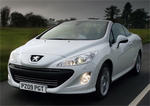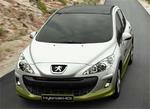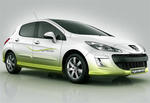
Peugeot introduces a new engine for the 807 range: a 2.2 liter HDi DPFS engine. The Peugeot 807 2.2 HDi is powered by a 2.2 liter diesel engine that develops 125 kW ( 170 hp ) and needs 7.2 liters of fuel to go 100 km.
Peugeot Press Release:
807 2,2 l HDi DPFS 125 kW (≈ 170 hp)
Driving pleasure and Practicality!
A new 2.2 liter HDi DPFS 125 kW (≈ 170 bhp) diesel engine has just been introduced to become the top of the range HDi diesel model for the 807.
It reinforces further the dynamic capabilities of
the range which is constantly being developed and improved.
This engine, which is fitted with twin turbo-chargers, can be already found powering the 407 and the 607, but sets itself apart from the crowd through its use of high technology. This engine provides a level of performance and driveability which is more frequently found in higher capacity engines, while still providing good fuel consumption (7.2 litres per 100 km) and reduced CO2 emissions (191 g/km).
With the introduction of this new HDi diesel engine, the range of power trains available in the 807 - which was updated last year with the introduction of the 2.0 litre HDi DPFS 88 and 100 kW (120 and 136 bhp) - now looks like this:
- 2,0 litre 16v HDi DPFS 88 kW (≈ 120 bhp), 300 Nm, 6-speed manual gearbox,
- 2.0 litre 16v HDi DPFS 100 kW (≈ 136 bhp), 320-340 Nm, 6-speed manual gearbox,
- 2.2 litre 16v HDi DPFS 125 kW (≈ 170 bhp), 370 Nm, 6-speed manual gearbox.
This new engine will also be available next
spring, in some countries, with a 6-speed automatic gearbox. The petrol range is made up of two models:
- 2.0 litre 16v 103 kW (≈ 141 bhp), 200 Nm, manual gearbox
- 2.0 litre 16v 103 kW (≈ 141 bhp), 200 Nm, automatic gearbox
This new 2.2 litre HDi DPFS engine is the result of the fourth phase of the co-operation between
PSA Peugeot Citroën and the Ford Motor Company.
It completes the HDi range of engines successfully developed in partnership since signing the co-operation agreement in 1998.
The four cylinder 2,179 cm3 engine has a sixteen valve cylinder head with twin overhead camshafts. It has a maximum power of 125 kW at 4,000 rpm and a generous maximum torque of 370 Nm at 1,500 rpm.
The torque and driveability at low engine speeds are particularly impressive, with the engine producing a torque of 200 Nm at 1,000 rpm and 280 Nm at 1,250 rpm.
The operating range is also very wide, with a
good spread of available torque at all engine speeds (with over 355 Nm at 3,000 rpm).
A new type of combustion chamber, a third generation common rail injection system with an increased injection pressure of 1,800 bar and the fitment of parallel sequential twin turbochargers are the main technological innovations of this engine.
Combining this technology brings excellent driveability to the 807 along with a convenience well suited to meeting the needs of a demanding customer base from all walks of life.
In France, this new engine is available in the Navteq version for 38,400 Euros.
It is worth noting that, within the past few weeks, the 807 has also benefited from the fitment of the new RT4 telematic system. Linked to a colour 3D screen and grouping together audio, GSM, GPS and Peugeot Emergency services, it includes a 30 GB hard disk enabling it to host maps covering the whole of Europe and to save up to 180 hours of music in MP3 format.
THE 2.2 LITRE HDi DPFS ENGINE – DW12BTED4
Parallel sequential twin turbo
The use of sequential twin parallel turbochargers is a world first on a four cylinder diesel car engine. The system (patented with Honeywell Turbo Technology) consists of two identical, small-diameter turbochargers.
At low engine speeds, a single turbocharger ensures engine responsiveness. It is then supported by a second turbocharger which starts to operate in parallel between 2,600 and 3,200 rpm, according to the applied load and atmospheric conditions. The entire range of engine speeds is, therefore, covered. The system is controlled entirely by the engine management electronic control unit (ECU). In addition, the low inertia and small size of the turbochargers reduces response time and improves throttle response.
The use of this technology enhances both driveability and, in particular, ensures excellent torque availability. This enables the driver to drive at lower engine speeds, thereby reducing fuel consumption.
The ECCS combustion chamber (Extreme Conventional Combustion System)
The special design and large diameter of the combustion chamber has enabled the engine’s compression ratio (16.6) to be reduced. This helps to reduce the quantity of incompletely burnt fuel by ensuring the minimum amount of fuel is in direct contact with the cylinder walls.
This is achieved by a special piston design and geometry. The pistons are manufactured from aluminium with a very high mechanical strength and thermal resistance. The geometry also makes it possible to significantly reduce SWIRL (air movement in the combustion chamber) and, therefore, limit thermal losses through the cylinder walls.
This results in better mixing of the air-fuel mixture, significantly improving the engine’s overall efficiency as well as reducing combustion noise.
A third-generation common rail with pressure increased to 1,800 bar
The ECCS combustion system is combined with a new third-generation Bosch common rail injection system which has an increased injection pressure of 1,800 bar (1,350 for the first generation).
The higher injection pressure is controlled by new piezo-electric injectors in which each nozzle is equipped with seven apertures with a diameter of 135 μm. The use of these injectors allows the number of individual injections per cycle to be increased, potentially up to six times. This results in a more precise injection of fuel and, therefore, more complete and uniform combustion.
Providing greater control of the combustion and optimising the air/fuel mixture reduces emissions at source.
The environment
This new 2.2 litre HDi DPFS engine is a worthy standard bearer in terms of environmental protection in a luxury MPV such as the 807.
It should be remembered that through its basic design, the diesel engine ensures excellent thermodynamic efficiency and that the fitment of an Hdi direct injection system increases this performance still further.
Thanks to the very high injection pressure of the common rail system and the extremely fine spray pattern of the diesel fuel into the combustion chamber, it allows more uniform and more complete combustion and significantly reduces emissions at source.
In addition, the twin turbochargers and the exhaust gas recirculation system play an active role in protecting the environment and in respecting the EURO 4 emission standard.
The combination of the new combustion chamber design, with the increased injection pressure of 1,800 bar, results in a reduction of emissions of around 30 % compared to the previous 2.2 litre HDi diesel engine fitted to the 807.
All the above technology is combined with the latest-generation Diesel Particulate Filter System (DPFS) featuring an additive-enhanced filter. This third generation, “octosquare” type diesel particulate emission filter has a service life of 180,000 km on the 2.2 litre HDi. This increased service life is made possible by improvements to both the additive and to the filter core.
The improved effectiveness of the Eolys additive, enables a reduction in additive delivery, thereby, reducing the amount of residue left inside the filter. The filter core has a new structural design, whose octosquare profile and larger diameter channels, greatly increases the residue storage capacity. Improved noise and vibration performance The use of a double-wall cylinder block, patented and manufactured directly in the foundry, significantly improves the engine’s acoustic performance.
Two counter-rotating balancing shafts, a dual mass engine flywheel and the design and damping performance of the engine mountings, all help to filter out engine vibrations.
A controlled “butterfly” valve located in the intake system, with a very short response time, helps to reduce engine vibration whilst the vehicle is at idle.
Maintenance
A large capacity two-section oil sump allows the oil change interval to be increased to 30,000 km.
Similarly, the ancillary drive belt and the engine accessories have been designed and strengthened to be maintenance-free for the life of the vehicle.ML6C MANUAL GEARBOX The 807 2.2 litre HDi DPFS engine is fitted with Peugeot’s ML6C six-speed manual gearbox whose gear lever is, as always in the 807, perfectly located in its elevated position on the fascia.
DYNAMIC CHARACTERISTICS
The 2.2 litre HDi DPFS engine gives the 807 excellent dynamic performance, flexibility at low engine speeds and great driveability.
Its performance bears witness to this. With only the driver, it takes only 31.4 seconds to cover 1,000 metres from a standing start, with in-gear acceleration between 80 and 120 kph taking just 9.6 seconds in 5th gear.
The maximum speed of 200 kph is obtained in 6th gear.
The technology used in this new engine and the wide spread of torque available at low engine speeds limits fuel consumption to 7.2 litres in the combined cycle and also reduces CO2 emissions to 191 g/km. The low fuel consumption and having a fuel tank with a capacity of 80 litres, gives the 807 an excellent range
WHEELS AND SUSPENSION
The choice of wheels and suspension are perfectly suited to the dynamic performance characteristics of this new engine.
The 807 benefits from McPherson-type front suspension and torsion beam rear suspension, both providing an original way to guarantee excellent road holding and steering accuracy.
The 807 2.2 litre HDi is fitted with rear dampers and an anti-roll bar specific to this model, while at the front the rear lower wishbone bushes have been uprated to improve rigidity. These changes enable the whole vehicle to achieve the best possible compromise between road holding and comfort for active safety and great driving pleasure.
With the 2.2 litre HDi engine, the 807 is exclusively fitted with 16" aluminium alloy wheels with 215/69 R 16 H tyres and tyre pressure sensors.
Of a size to match the dynamic requirements of the vehicle, the braking system uses 310 x 32 mm ventilated discs at the front, with double piston calipers.
This ensures the 807 has powerful, controllable and durable braking. Anti-lock brakes, wheel by wheel electronic brake force distribution (EBFD) and emergency brake assist (EBA) complete the system. As with all 807s, this model benefits from the latest Bosch ESP (Electronic Stability Programme) system with a specifically calibrated management system to correct any early signs of "understeer" or "oversteer".











